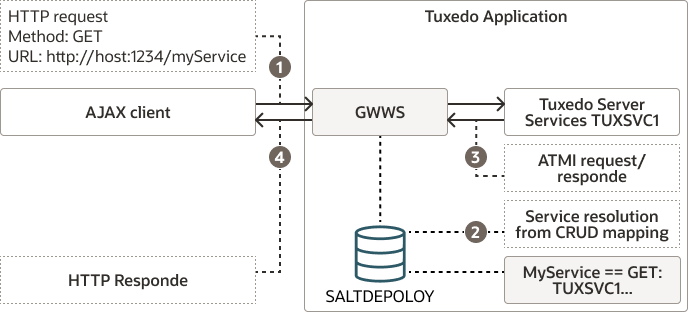1.1.2 Representational State Transfer (REST) Support
SALT provides access to existing Tuxedo servers using a simplified HTTP format, following a principle more commonly known as Representational State Transfer (REST). In order to use REST, two new sections will need to be configured in SALTDEPLOY: HTTP/Network to specify the HTTP and/or HTTPS (SSL) port that the gateway will use to listen for REST requests, and HTTP/Services to specify which Tuxedo services are to be exposed and how; the combination of REST service name (arbitrary choice that will identify a REST servicein the calling URL) + HTTP method (GET/POST/DELETE/PUT) will map to the actual Tuxedo service so that CRUD principles can be expressed.
Once enabled, the following will be the behavior at runtime:
- A client program sends an HTTP message to GWWS. This message contains the verb (
GET,POST,PUTorDELETE), headers (content-type, etc.) and URL. - "GWWS uses the verb to determine what to do with data: for
GETorDELETE, the query string is used to construct a request for the actual Tuxedo service, forPOSTorPUT, the post data is used. - The URL part of the request is used to determine the service to be called: for example, a call such as '
POSThttp://host:1234/myService' results in GWWS assembling a request for the Tuxedo service mapped to by the 'myService' name inSALTDEPLOY(e.g., 'myService' withGETmethod may map to a Tuxedo service namedBALANCE), converting the reply from FML32 to JSON (assuming service returns FML32) and sending it back to the caller.
The following figure illustrates the REST in GWWS Architecture
Figure 1-2 REST in GWWS Architecture

Parent topic: Understanding SALT